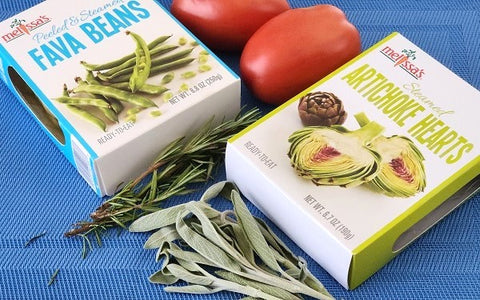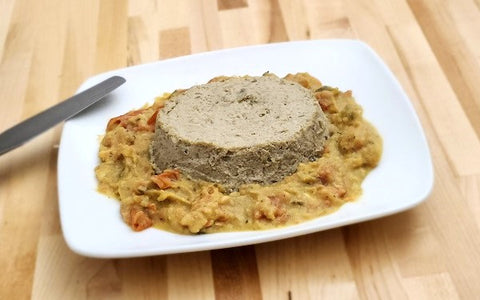Special Occasion for Two: Artichoke Heart Custard with Fava Sauce

Over half of the U.S. adult population, some 154 million, qualify as being overweight or obese. Another 29 million of us have Diabetes, many as a direct result of being overweight. Then there are the 23.9 million overweight children who are dutifully following the example of their XXL adult role models. Diabetes and these extra pounds cost this country billions annually in both medical and economic resources; not to mention the effect these weight-related maladies have on a person’s overall mental well-being and happiness. However, both diabetes and being overweight are very manageable, even preventable, with a few lifestyle tweaks. By maintaining a sensible diet in conjunction with some consistent exercise, no matter how minimal, we can all be in total control of our own weight. One easy way to start taking that control is to make decisions about the foods we eat based on the glycemic index [GI] and glycemic load [GL].
Simply put, our bodies convert all foods into sugar calories that provide energy to the body via the blood stream. The Glycemic Index assigns a score of 1 to 100 to all foods based how speedy the body converts that food into sugar. Foods that break down slowly enable the body to assimilate theses calories of energy more efficiently without overwhelming the body with more sugar than it can process. While this is especially important for diabetics who process sugars much slower than others, everyone can benefit from eating foods that have low glycemic scores since they also reduce appetite and encourage the metabolism to burn body fat. Conversely, a diet of foods high on the glycemic charts have been proven to actually increase appetite and impede effective fat oxidation.
A QUICKIE GLYCEMIC PRIMER:
- The glycemic index of a food compares its effect on blood sugar level to that of pure glucose, which has a score of 100. White breads, which are made of processed white flour, are at the top of this scale, scoring a “perfect” 100 on the glycemic index. For perspective, a score of 55 or below denotes a low glycemic index food; 70 or above is considered very high. Serving size is not a consideration in arriving at a food’s Glycemic Index number.
- The glycemic load, on the other hand, focuses on how much digestible carbohydrates (sugars) a food contains in a typical single serving, which is defined as approximately 3.5 ounces. For glycemic load, a score of 20 or more is high, while 10 or less is low.
Elegance and low carb dining can be a challenge since one of the main ingredients when planning a special occasion dinner-for-two is to create an ambiance of culinary indulgence. More plainly, presenting a dish that is obviously the result of some serious carb-counting is not very sexy! I recently was faced with this dilemma i.e. that my low carb regime was my problem / not that of a special dinner guest. Then an interesting recipe title caught my eye on the ‘net – an artichoke heart custard? And with a fava bean sauce, no less! Just what the doctor (my doctor) ordered, a dish with very low Gl and GL scores, yet it also sounded like an epicurean delight that any Michelin star maître d' would approve!
The recipe called for fresh artichokes peeled down to their hearts and fresh fava beans shelled, blanched, chilled and then skins removed. Half the recipe’s instructions were taken up with this needless culinary drudgery made immensely easier with Melissa’s Steamed Artichoke Hearts and Peeled & Steamed Fava Beans! As a fresh produce professional and pretty good cook, the words “canned,” “packaged,” and even “frozen” have never been in my vocabulary and rarely make an appearance on a shopping list. Still, I must admit that Melissa’s whole line of steamed produce items, especially these two, would not be distinguishable in freshness, flavor, or texture if in a blind tasting up against the same items prepped and cooked from scratch. That’s a fact – so why bother?
Delicious and nutritious, the Fava bean is very high in fiber and iron while being very low in sodium and fat. Favas have no cholesterol and so much protein that they have been called "the meat of the poor." Fava beans are one of the oldest crops cultivated by man. Archaeological findings at Iron Age and Bronze Age settlements in Europe, dating back to 3300 BC, indicate that the bean has been an important staple food source for thousands of years. In doing research for this article, I even found one source claiming with matter-of-fact expertise that "the easy-to-grow Favas were probably the magic beans that Jack used to grow his stalk into the clouds." Obviously, a historian who takes his unicorns and giants a bit too seriously!
Before the Americas were discovered, along with this continent's multitude of bean varieties, Favas were the only legume that Europeans consumed. Still, despite the bean's long history as well as being a key ingredient in Hannibal Lecter’s infamous recipe in the movie Silence of the Lambs, the Fava has never garnished much attention in the U.S. marketplace. The bean does require a bit of labor-intensive preparation that is not a good fit for the typical American TO GO lifestyle, even if the bean is very helpful in stalking giants. Conversely, Melissa’s Steamed & Peeled Fava Beans, which can be used right out of the package, are made for the 21st Century kitchen!
Using these two time-saving components, the preparation is very straightforward: a food processor to puree both the custard components and the fava bean sauce ingredients. Place the custard in ramekins to bake, then surround each custard with the sauce. Simple, especially if you learn by the mistake I made on the first batch – forgetting to surround the ramekins with water for the bake! In defense, things can get a little hectic when photographing the preparation stages of a recipe. I was so focused on the shot of the ramekins in the baking dish and then popped them right in the oven once I got the right shot; the omission of the water was not discovered until the bake was done. While the taste was fine, the custard was also so affixed to the ramekin that extrication proved fatal. The “with water” do-over was successful. Enjoy and don’t forget the candles!
Artichoke Heart Custard with Fava Sauce
Servings 2
Ingredients
For the custard:
2 pkgs Melissa’s Steamed Artichoke Hearts
1 cup plus 2 tablespoons heavy cream, divided
2 large eggs, at room temperature, beaten
Kosher salt and freshly ground white pepper
Boiling water
2 8-ounce ramekins
For the sauce:
1 pkg Melissas Peeled & Steamed Fava Beans
2 oz water
1/4 cup olive oil
1 garlic clove, minced
1/2 teaspoon sage, chopped
1/2 teaspoon rosemary, chopped
1 Roma tomato —peeled, seeded, chopped
2 tablespoons lemon Juice
Preparation
Place artichoke hearts in food processor. Add the 2 tablespoons of the cream: puree until smooth. Add the remaining cream along with the eggs and season with 1/2 teaspoon of salt and a pinch of pepper, pulse to incorporate.
Coat 8-ounce ramekins with cooking spray or butter, then set them in a baking dish. Pour the custard into the ramekins. Fill the dish with enough boiling water to reach halfway up the sides of the ramekins. Bake the custards for 45 minutes at 325° F. A good test: knife inserted in the centers comes out clean. Remove the ramekins from the water.
Sauce: While custards are baking, purée the favas and water in a food processor until smooth. Heat the oil in a skillet; sauté the garlic, sage and rosemary over a medium-low flame for 1 minute. Then mash in the tomato pieces and lemon juice, simmer for about 5 minutes. Finally, stir in purée and cook until thoroughly combined. Season with salt and pepper to taste
Plating: Run the blade of a thin knife around each custard, then carefully invert onto a plate. Spoon the sauce around the custard, topped with fresh diced tomato pieces and a few sage leaves.

